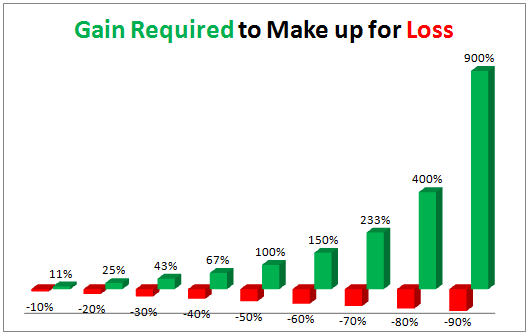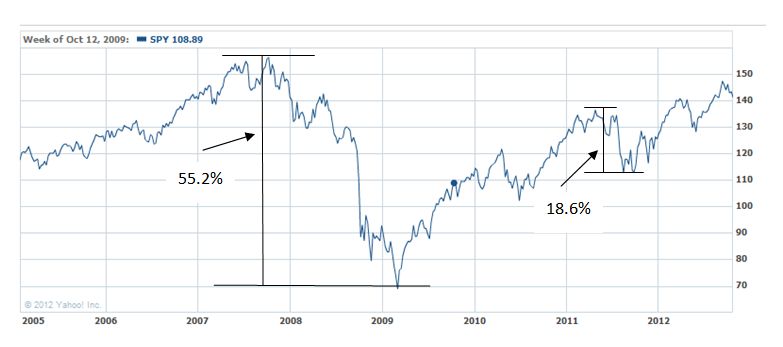Re-balance Cycle Reminder
Based on our monthly re-balance calendar, the next re-balance time will be on Monday, November 19, 2012. You can also find the re-balance calendar of 2012 on ‘Dashboard‘ page once you log in.
As a reminder to expert users: advanced portfolios are still re-balanced based on their original re-balance schedules and they are not the same as those used in Strategic and Tactical Asset Allocation (SAA and TAA) portfolios of a plan.
Also please note that we now list the next re-balance date on every portfolio page.
New Features
We continue to roll out some new features: we recently introduced My Favorite Portfolios feature. When you see a portfolio that is of interests to you and you would like to visit it later, you can click on the star icon below the portfolio title and this portfolio is added to the My Favorite Portfolios table which can be accessed from ‘Dashboard‘.
How to Evaluate A Portfolio or Fund
By definition, investors are looking for highest returns possible for their investments. It is thus very natural to look at the past return data of a portfolio or a fund first. However, return numbers are not the only story: risk or portfolio’s fluctuation or steadiness is equally important. In fact, for conservative investors (who are the majority of MyPlanIQ users), risk is foremost important.
There are many ways to measure risk. Intuitively, risk should be defined as the likelihood of permanent capital loss, as this is the ultimate concern for an investor. However, in practice, it is not only hard to measure the likelihood of permanent capital loss, it is also psychologically challenging to have a portfolio or an investment that experiences large loss, only to recover eventually later.
Humans are very easily confined to short term memory or current situations. For many, it is hard to visually or numerically comprehend a 50% loss in 2008 if one didn’t actually experience that period of the markets. In abstract, 50% loss is just a number. But when you are actually seeing your net worth cut in half, it is a very different story. In fact, even a 30% loss of one’s total worth is way more excruciating than the numeric -30%. The following chart has been shown by many, but we think it is still worthwhile to present it here:
h/t fusioninvesting.com
So, a loss of 50% requires 100% (double) gain while 30% loss requires 43% gain. The asymmetric relationship of gain and loss makes loss far more challenging, both psychologically and practically.
In practice, risk of a portfolio can be described as standard deviation or volatility, which measures the fluctuation of the daily or weekly or monthly return data series of a portfolio. However, psychologically, many professionals prefer using maximum draw down as the yard stick for risk. Draw down of a period of time is defined as the percentage loss from a peak to a trough after the peak. The following chart of SPY (SPDR S&P 500 ETF) between 2005 to present shows the maximum drawdown of this period (55.2%) as well as that (18.6%) in 2011.
Maximum drawdown measures the wealth effect: for example, suppose that the total amount of your portfolio that holds 100% SPY reached $100,000 on October 11, 2007 (the day S&P 500 reached the peak), you would think you were $100,000 rich. On the day March 9, 2009, your wealth would shrink to only $44,800 (55.2% reduction).
We thus prefer using standard deviation as the first yard stick to measure a portfolio’s volatility but using Maximum drawdown as the hard stop gap measure on a portfolio’s risk.
To get an overall portfolio performance measurement, one should include both returns and risk. Sharpe ratio is the most widely used metric for this purpose.
Sharpe ratio intends to normalize a portfolio’s risk: it measures excessive return per one standard deviation, i.e. excessive return divided by standard deviation. The excessive return is defined as the return minus risk free (cash) return. For example, if portfolio A returns 6% with a Sharpe ratio 0.5 (or 50%) and portfolio B returns 12% with a Sharpe ratio 0.4 (40%), one should prefer portfolio A, or at least understand that portfolio A achieves the better return per risk unit (one standard deviation) than portfolio B because in theory, one can leverage portfolio A twice and achieve better return than portfolio B with the same amount of risk (this is, of course, only valid in theory). Sharpe ratio is also called risk adjusted return.
Sharpe ratio is often criticized by its using standard deviation as the measure of risk which includes both up and down returns. Realistically, people would prefer only measuring volatility of down days. Such a measure is called semi-variance in mathematics. Sortino ratio uses only the down volatility instead of the standard deviation. By doing so, it better measure how much risk adjusted return a portfolio can achieve.
We would again use Sharpe ratio as the first line of measurement for a portfolio’s overall performance and uses Sortino ratio to get a more realistic measurement.
The following shows some of the 10 model portfolios for 5 featured ETF plans (one Strategic Asset Allocation – Equal Weight and one for Tactical Asset Allocation):
Portfolio Performance Comparison (as of 10/26/2012)
*: NOT annualized
**YTD: Year to Date
Detailed and up to date link here >>
The maximum drawdown for the 10 year period (you can find this on the above link by clicking on the button + More Performance Analytics Comparison:
| 1 Yr | 3 Yr | 5 Yr | 10 Yr | Inception | |
| MyPlanIQ Diversified Core Allocation ETF Plan Strategic Asset Allocation – Equal Weight Moderate | 6.7 | 10.5 | 36.3 | 36.3 | 36.3 |
| MyPlanIQ Diversified Core Allocation ETF Plan Tactical Asset Allocation Moderate | 4.8 | 10.5 | 11.2 | 14.1 | 14.1 |
| Permanent Global Portfolio ETF Plan Strategic Asset Allocation – Equal Weight Moderate | 7.9 | 15.6 | 33.6 | 33.6 | 33.6 |
| Permanent Global Portfolio ETF Plan Tactical Asset Allocation Moderate | 3.9 | 9.1 | 16.3 | 16.3 | 16.3 |
| Retirement Income ETFs Strategic Asset Allocation – Equal Weight Moderate | 7.3 | 11.6 | 41.5 | 41.5 | 41.5 |
| Retirement Income ETFs Tactical Asset Allocation Moderate | 3.3 | 7.7 | 15.4 | 15.4 | 15.4 |
| Six Core Asset ETFs Strategic Asset Allocation – Equal Weight Moderate | 6.7 | 12.2 | 38.9 | 38.9 | 38.9 |
| Six Core Asset ETFs Tactical Asset Allocation Moderate | 3.5 | 9.5 | 11.7 | 11.7 | 11.7 |
| Vanguard ETFs Strategic Asset Allocation – Equal Weight Moderate | 7.3 | 15.2 | 41.2 | 41.2 | 41.2 |
| Vanguard ETFs Tactical Asset Allocation Moderate | 3.4 | 11.1 | 13.2 | 15.2 | 15.2 |
From the above, one can see that Retirement Income ETFs Tactical Asset Allocation Moderate has the highest Sharpe ratio (0.99) while Six Core Asset ETFs Tactical Asset Allocation Moderate has the lowest maximum drawdown (11.7%) in the 10 year period. In the last 3 year period, Retirement Income ETFs Tactical Asset Allocation Moderate again has the highest Sharpe ratio (0.98) and the lowest Maximum drawdown.
However, year to date, Retirement Income ETFs Tactical Asset Allocation Moderate has lagged behind many Strategic Asset Allocation portfolios in terms of portfolio returns.
To summarize, Sharpe ratio and maximum drawdown are the two key metrics we at MyPlanIQ watch most closely. Other metrics such as standard deviation and Sortino ratio are also helpful to gain insights into the behavior of a portfolio/fund.
Market Overview
Stock markets have been affected by a string of bad company earnings news. We observe some important change in our major asset trend ranking: US stocks (VTI) is now out of top 3 spots. In fact, emerging market bonds and US high yield bonds (JNK) are now in the top 3 spots, along with international REITs. US REITs is now ranked below total US bonds (BND), a significant development.
We now have somewhat a perfect ‘storm’: hurricane Sandy rampaging through the East Coast and the weakening corporate earnings. Markets might or might not change their trends dramatically from here. At the moment, the best is to stay the course and watch the ‘storm’ and react to it accordingly.
See 360° Market Overview for more asset class trends.
We remain deeply skeptical on this rally.
We again copy our position statements (from previous newsletters):
Our position has not changed: We still maintain our cautious attitude to the recent stock market strength. Again, we have not seen any meaningful or substantial structural change in the U.S., European and emerging market economies. However, we will let markets sort this out and will try to take advantage over its irrational behavior if it is possible.
We again would like to stress for any new investor and new money, the best way to step into this kind of markets is through dollar cost average (DCA), i.e. invest and/or follow a model portfolio in several phases (such as 2 or 3 months) instead of the whole sum at one shot.
Latest Articles
- Unemployment: Part of the Economic Cycle or Secular Shift?
- New 401(k) and IRA Limits for 2013
- Wine, Beer, and Spirits: Sin Stocks Outperform
- Four ways to squeeze inflation risk from your portfolio
- When Will the Fed Raise Interest Rates?
- How Long-Term Investors Address Short-Term Risks
- Invest for the Long Run?
- $ ?s: How should I go about picking conservative investments for my 401(k)?
- October 22, 2012: Income And Conservative Portfolio Review
- Net Wealth Shock and Portfolio Diversification
- You can count on new burst of infrastructure spending
How can we improve this newsletter — we value your inputs –Thanks to those who have already contributed — we appreciate it.



 Diversified Asset Allocation Portfolios For Your Plans
Diversified Asset Allocation Portfolios For Your Plans

Interesting topic – Sharpe Ratios
Question: Please explain how I can compare the Sharpe ratios you list with those listed in the Hulbert Financial Digest. It uses a standard monthly unit for each time period, so that one can easily compare the Sharpe value across time periods, for example they list the 5 year and 10 year Sharpe ratios for a leading low volitility newsletter as .16 and .17.
What factor would I apply to your ratios to obtain comparative figures?
Thank you
We use daily returns to calculate Sharpe ratios (and adjust that to various time period). Thus our Sharpe ratios are more fine grained. They are comparable with those in Hulbert, however. Also, bear in mind that we report Sharpe ratio using percentages, so you might want to convert that to decimal. 5 and 10 years are the numbers you can use to compare.
Thanks,
John
We do provide a calculator for periodic Sharpe Ratio. Here is how to use it:
Clicking the links in the article above, you will be led to the portfolio page, like http://www.myplaniq.com/LTISystem/jsp/portfolio/ViewPortfolio.action?ID=17295, you can find a button called “More Performance Analytics”. Click it and then you will see another button called “Calculate Performance For A Period”. Click on it and you will be asked to enter the start date and the end date of your interested period. Then, you will get the annualized Sharpe Ratio calculated on daily data. You can set the same 5-year or 10-year period as those given by other newsletters for comparison.